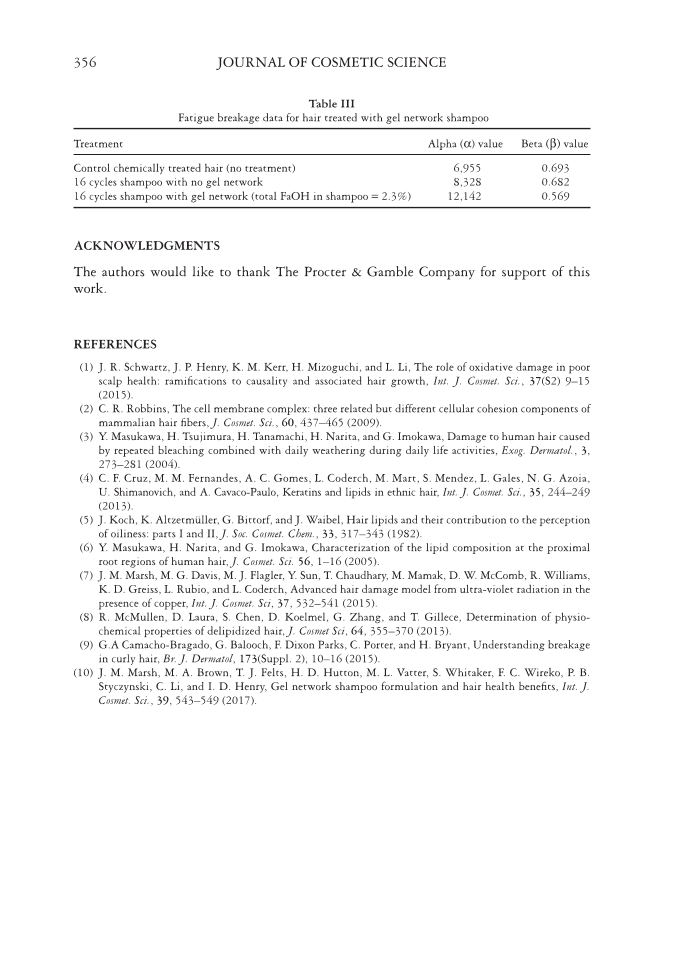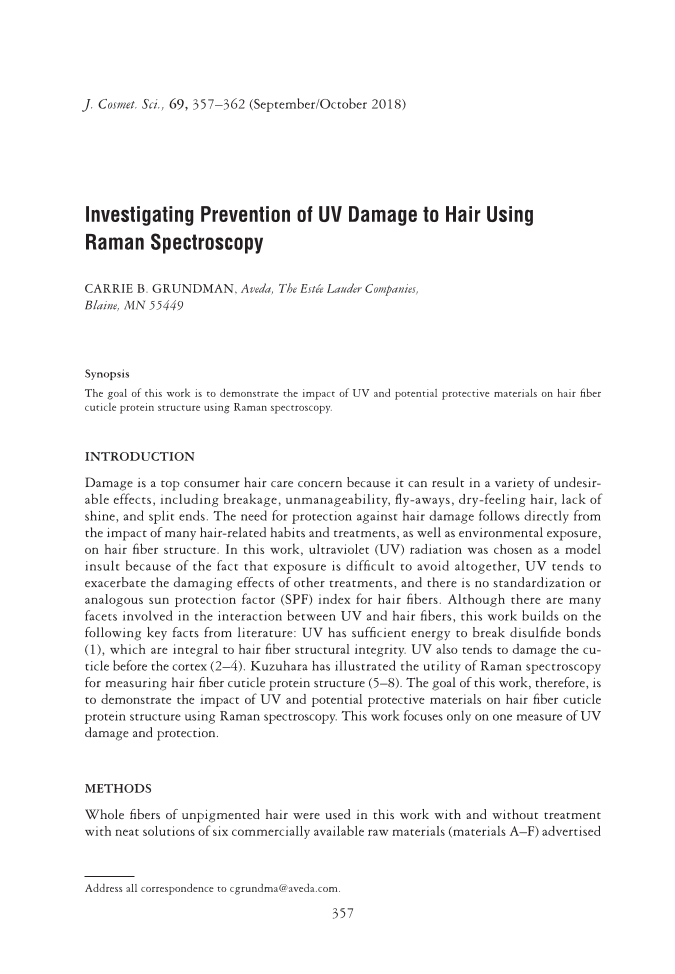JOURNAL OF COSMETIC SCIENCE 356 ACKNOWLEDGMENTS The authors would like to thank The Procter & Gamble Company for support of this work. REFERENCES (1) J. R. Schwartz, J. P. Henry, K. M. Kerr, H. Mizoguchi, and L. Li, The role of oxidative damage in poor scalp health: ramifi cations to causality and associated hair growth, Int. J. Cosmet. Sci., 37(S2) 9–15 (2015). (2) C. R. Robbins, The cell membrane complex: three related but different cellular cohesion components of mammalian hair fi bers, J. Cosmet. Sci., 60, 437–465 (2009). (3) Y. Masukawa, H. Tsujimura, H. Tanamachi, H. Narita, and G. Imokawa, Damage to human hair caused by repeated bleaching combined with daily weathering during daily life activities, Exog. Dermatol., 3, 273–281 (2004). (4) C. F. Cruz, M. M. Fernandes, A. C. Gomes, L. Coderch, M. Mart, S. Mendez, L. Gales, N. G. Azoia, U. Shimanovich, and A. Cavaco-Paulo, Keratins and lipids in ethnic hair, Int. J. Cosmet. Sci., 35, 244–249 (2013). (5) J. Koch, K. Altzetmüller, G. Bittorf, and J. Waibel, Hair lipids and their contribution to the perception of oiliness: parts I and II, J. Soc. Cosmet. Chem., 33, 317–343 (1982). (6) Y. Masukawa, H. Narita, and G. Imokawa, Characterization of the lipid composition at the proximal root regions of human hair, J. Cosmet. Sci. 56, 1–16 (2005). (7) J. M. Marsh, M. G. Davis, M. J. Flagler, Y. Sun, T. Chaudhary, M. Mamak, D. W. McComb, R. Williams, K. D. Greiss, L. Rubio, and L. Coderch, Advanced hair damage model from ultra-violet radiation in the presence of copper, Int. J. Cosmet. Sci, 37, 532–541 (2015). (8) R. McMullen, D. Laura, S. Chen, D. Koelmel, G. Zhang, and T. Gillece, Determination of physio- chemical properties of delipidized hair, J. Cosmet Sci, 64, 355–370 (2013). (9) G.A Camacho-Bragado, G. Balooch, F. Dixon Parks, C. Porter, and H. Bryant, Understanding breakage in curly hair, Br. J. Dermatol, 173(Suppl. 2), 10–16 (2015). (10) J. M. Marsh, M. A. Brown, T. J. Felts, H. D. Hutton, M. L. Vatter, S. Whitaker, F. C. Wireko, P. B. Styczynski, C. Li, and I. D. Henry, Gel network shampoo formulation and hair health benefi ts, Int. J. Cosmet. Sci., 39, 543–549 (2017). Table III Fatigue breakage data for hair treated with gel network shampoo Treatment Alpha (α) value Beta (β) value Control chemically treated hair (no treatment) 6,955 0.693 16 cycles shampoo with no gel network 8,328 0.682 16 cycles shampoo with gel network (total FaOH in shampoo = 2.3%) 12,142 0.569
J. Cosmet. Sci., 69, 357–362 (September/October 2018) 357 Investigating Prevention of UV Damage to Hair Using Raman Spectroscopy CARRIE B. GRUNDMAN, Aveda, The Estée Lauder Companies, Blaine, MN 55449 Synopsis The goal of this work is to demonstrate the impact of UV and potential protective materials on hair fi ber cuticle protein structure using Raman spectroscopy. INTRODUCTION Damage is a top consumer hair care concern because it can result in a variety of undesir- able effects, including breakage, unmanageability, fl y-aways, dry-feeling hair, lack of shine, and split ends. The need for protection against hair damage follows directly from the impact of many hair-related habits and treatments, as well as environmental exposure, on hair fi ber structure. In this work, ultraviolet (UV) radiation was chosen as a model insult because of the fact that exposure is diffi cult to avoid altogether, UV tends to exacerbate the damaging effects of other treatments, and there is no standardization or analogous sun protection factor (SPF) index for hair fi bers. Although there are many facets involved in the interaction between UV and hair fi bers, this work builds on the following key facts from literature: UV has suffi cient energy to break disulfi de bonds (1), which are integral to hair fi ber structural integrity. UV also tends to damage the cu- ticle before the cortex (2–4). Kuzuhara has illustrated the utility of Raman spectroscopy for measuring hair fi ber cuticle protein structure (5–8). The goal of this work, therefore, is to demonstrate the impact of UV and potential protective materials on hair fi ber cuticle protein structure using Raman spectroscopy. This work focuses only on one measure of UV damage and protection. METHODS Whole fi bers of unpigmented hair were used in this work with and without treatment with neat solutions of six commercially available raw materials (materials A–F) advertised Address all correspondence to cgrundma@aveda.com.
Purchased for the exclusive use of nofirst nolast (unknown) From: SCC Media Library & Resource Center (library.scconline.org)









































































































